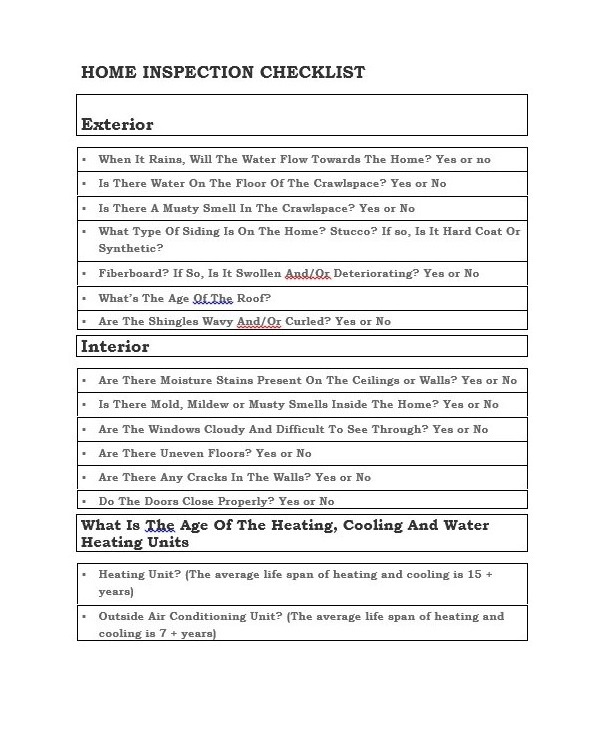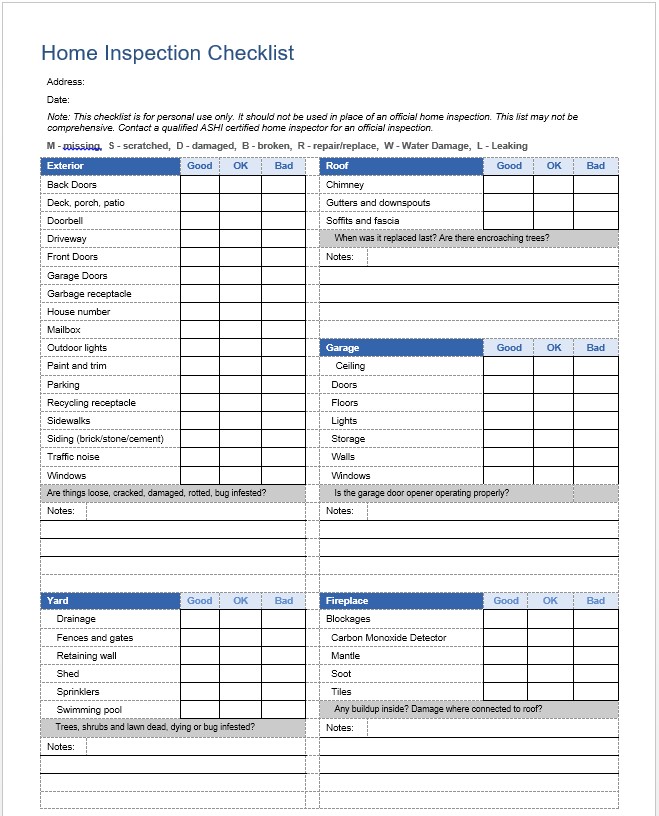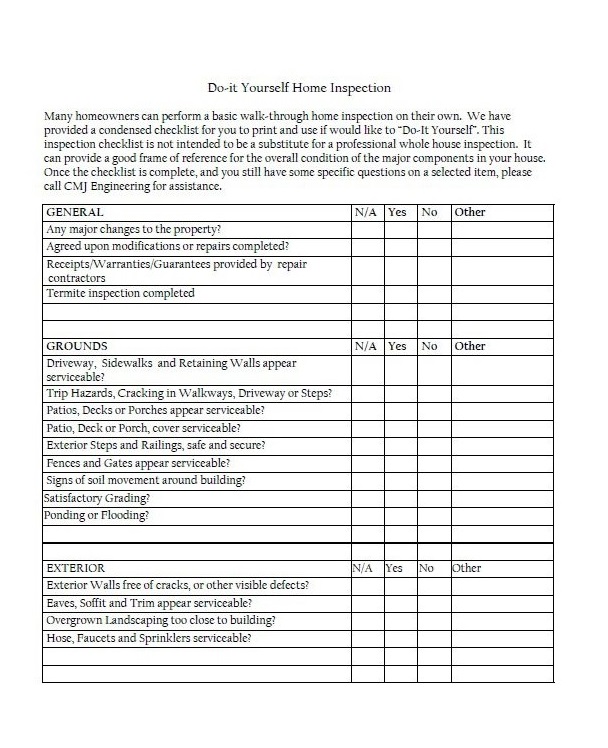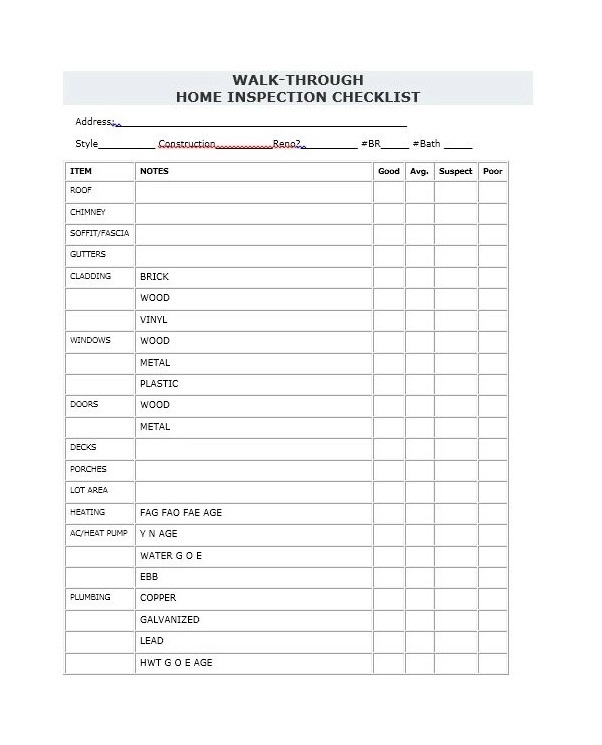A home inspection checklist is a valuable tool for buying a home. It guides home inspectors to ensure that every critical aspect of the house is examined and evaluated. It includes the home’s structure, systems, and components, from the roof to the foundation.
The role of a home inspection checklist in home buying is significant. It assists potential customers in understanding the house condition they are considering purchasing. Customers can make knowledgeable decisions by determining problems like structural harm or outdated systems. They may negotiate for repairs, ask for a price reduction, or even leave the purchase if the inspection reveals major problems.
Aspects of Home Inspection Checklist
It is really important to understand home inspection checklist when you are planning to buy a house. Whether it is old or recently built one, you should make sure the one you are buying has good result on the checklist.
Everyone would be able to do a comprehensive examination when they have home inspection checklist to guide. If you already have visualization of structure details and physical systems from floor to the roof, you will be able to save money on renovation since you can make sure that there’s no need for major improvement.
Electrical System
You need the help of professional in order to detect if there’s any problem with the electrical system. The home inspectors will definitely let you know if the electrical box is already worn out, so it doesn’t adhere the city code. Afterwards, you will be able to consult with them about the best brand and most suitable one to substitute it.
Roof Examination
You need to know if the seller is willing to pay you the old roof or he may offer you the roof certification. If they have no policy about these matter, you should better get your own help. The home inspector will make sure that the company you are having business with is a credible with good reputation. This way, you will be at ease since they would like to help you in the future when you find some cases.
Air Conditioning and Heating System
This section of home inspection checklist guides you to identify if the heat exchanger is still properly working or not. If you choose to ask help of home inspector, they likely absolutely report to you how much the reparation costs or replacement if needed.
Wood
Wood destroying pests is one of main problem that would be found especially in area with warm climates. If the house you are going to buy is located in warm climate, you sure need to inspect this thoroughly. This way, you will be able to learn if the house has termites, beetles or dry rot which should be one consideration.
Chimneys
If the house is already old enough, you should notice this specific section of home inspection checklist. The brick that constructs the chimney probably crumbling or the flue liner isn’t available because it’s actually older than the house.
Septic and Sewer Structure
Beside the chimney, another problem that mostly found in old house is sewer and septic system. You should make sure that the sewer is connected as it should be. With the latest technology, you can learn the condition of sewer system by inserting camera to the sewer lines passing through the main line.
Plumbing
Similar to sewer system, you also should check if there’s any problem with the plumbing or not. If you find the water on bathroom can hardly flow through the disposal, it tells you to do some reparation or replacing the pipes as needed.
The Importance of a Home Inspection Checklist
It serves as a roadmap to ensure that every critical part of the home is checked and evaluated. Here’s why a home inspection checklist is crucial:
Identifying Potential Issues: It assists in determining possible problems that might not be perceptible to the untrained eye. It could include structural problems, outdated electrical systems, plumbing issues, or a faulty HVAC system. By determining these problems early, you can avoid expensive restorations.
Facilitating Negotiations: If it shows any issues, the buyer can use this report to deal with the seller. It could involve asking the seller to fix the problems before approaching, reducing the cost to account for the price of restorations, or even backing out of the deal if the issues are too important.
Planning for Future Maintenance: It can help buyers plan for future maintenance. By knowing the situation of the home’s different systems and parts, buyers can anticipate when they might require to complete restorations or reserves and funding accordingly.
Ensuring Safety: A thorough It can reveal safety issues like radon, carbon monoxide, and mold, which are serious health hazards. Learning about these problems allows you to manage them and provide the home is safe before moving in.
Peace of Mind: Finally, a home inspection checklist provides peace of mind. Buying a home is a substantial buy, and understanding that the home has been checked helps ensure you make a sound decision.
It helps identify potential issues, facilitates negotiations, helps prepare for coming care, ensures protection, and delivers peace of mind. A home inspection checklist can avoid future issues and provide your new home is a good buy.
How to Use a Home Inspection Checklist
It effectively provides you to recognize all critical areas during a home inspection. Here’s a step-by-step guide on how to use it:
Understand the Checklist: Before starting the inspection, take some time to comprehend the checklist. Familiarize yourself with the different sections and items on the list. The checklist will likely be divided into sections established on the home’s various systems and components, such as the exterior, interior, plumbing, electrical, HVAC, etc.
Walk Through the Home: Start your inspection by walking through the home. As you move through each area, refer to the corresponding section on your checklist. It will ensure that you get everything.
Check Off Items: As you inspect each item on the checklist, check it off. It will help you track what you’ve inspected and what’s left to inspect.
Take Notes: If you find any issues during the inspection, note them on the checklist. Be as detailed as possible. It will be helpful when you’re discussing the findings with the seller or when you’re planning for repairs.
Take Pictures: Taking pictures of any problems is also a fine idea. It provides a visual record that can be helpful for future reference or discussions with the seller.
Review the Checklist:
- After you’ve completed the review, check the list and your notes.
- Make sure you have caught everything.
- If there are any items you couldn’t inspect for some reason, make a note of them and plan to revisit them if possible.
Discuss the Findings: Finally, discuss the findings with the vendor. The information from the checklist can be used to deal with repairs, a more down cost, or to determine whether to move forward with the purchase.
A home inspection checklist is a tool to help you, but it’s not a substitute for a professional home inspection. Hiring a professional home inspector with the training and experience to spot issues you might miss is always a suitable idea.
Tips for Conducting a Home Inspection
Conducting a home inspection can be daunting, especially for first-time homebuyers. Here are some practical tips and best practices to help you navigate the process:
- Hire a Professional: While a home inspection checklist can be useful, it’s not a substitute for a professional home inspection. Professional home inspectors have the training and experience to spot potential issues you might miss.
- Be Present During the Inspection: Try to be present during the inspection. It will allow you to ask questions and better understand any potential issues.
- Look Beyond the Aesthetics: Don’t let a fresh coat of paint or a well-manicured lawn distract you from potential issues. Look beyond the surface and focus on the home’s systems and structures.
- Check the Major Systems: Pay close attention to the home’s major systems, including the plumbing, electrical, and HVAC. Issues with these systems can be costly to repair.
- Remember the Exterior: The home’s exterior is as important as the interior. Be sure to check the roof, gutters, siding, and foundation for any signs of damage or wear.
- Take Your Time: Don’t rush the inspection. Take your time to inspect each area of the home thoroughly. It’s better to spend a little extra time now than discover issues after purchasing the home.
- Ask Questions: If you need clarification on something, ask questions. Whether you’re asking the seller, your real estate agent, or the home inspector, getting clarification on potential issues is important.
- Use the Information: Use the information gathered during the inspection to make an informed decision about the home purchase. It could involve negotiating repairs with the seller, adjusting your offer, or even deciding to leave the purchase.
A home inspection aims to uncover potential issues that could affect the home’s value or require costly repairs. Following these tips can ensure a thorough inspection and make an informed decision about your home purchase.
Common Mistakes to Avoid During Home Inspections
It is a crucial aspect of the home-buying procedure, but it can also be a source of stress and confusion, especially for first-time homebuyers. Here are some mistakes to avoid:
- Not Hiring a Professional: While saving money by accomplishing the check yourself might be tempting, this can often lead to missed or overlooked issues. Experienced house inspectors have the training and knowledge to spot issues you must notice.
- Skipping the Inspection: Some customers may feel a check is unnecessary, especially if the home appears in good condition. However, even new homes can have hidden problems. An inspection can assist in uncovering these problems before you finalize your purchase.
- Not Attending the Inspection: You should always try to be current during the check. It allows you to ask questions, understand possible problems, and look at the house’s situation firsthand.
- Ignoring the Inspector’s Recommendations: If your inspector recommends further evaluation by a specialist (like a plumber or electrician), pay attention to this advice. These professionals can provide a more in-depth analysis of specific systems and potentially uncover serious issues.
- Focusing Only on Cosmetic Issues: Cosmetic issues are easy to spot but usually the least of your worries. Don’t let minor cosmetic issues distract you from major structural or system issues.
- Not Reading the Inspection Report: The inspector will give thorough information of their findings after the check. Make sure to read this information carefully. It can provide useful details about the house’s situation and help you create a knowledgeable determination.
You can make the most of your house inspection and ensure you’re fully briefed about the property before buying.
The different Types of Home Inspection Checklists
The are some different types of home inspection checklists, such as:
Home Kitchen Inspection Checklist
This type of checklist focuses on the kitchen area of a home. It includes checking the appliances’ functionality, inspecting the plumbing system for leaks, ensuring the exhaust fan works properly, and looking for signs of pest infestations. It also includes reviewing the countertops, cabinets, and flooring.
Home Fire Inspection Checklist
This checklist is used to identify potential fire hazards in a home. It includes checking for properly functioning smoke detectors, ensuring no overloaded electrical outlets or extension cords, verifying that fire extinguishers are present and fully charged, and inspecting for proper clearance around heating equipment.
Home Final Inspection Checklist
This checklist is used during the final walk-through before purchasing a home. It includes checking that all agreed-upon restorations have been completed, all appliances are using control, and no new problems have arisen since the initial check.
Home Rental Inspection Checklist
It is used by lessors and residents during the move-in and move-out process. It includes checking for harm to walls, foundations, and fixtures, ensuring all appliances are in operating order, and confirming that the property is clean and well-maintained.
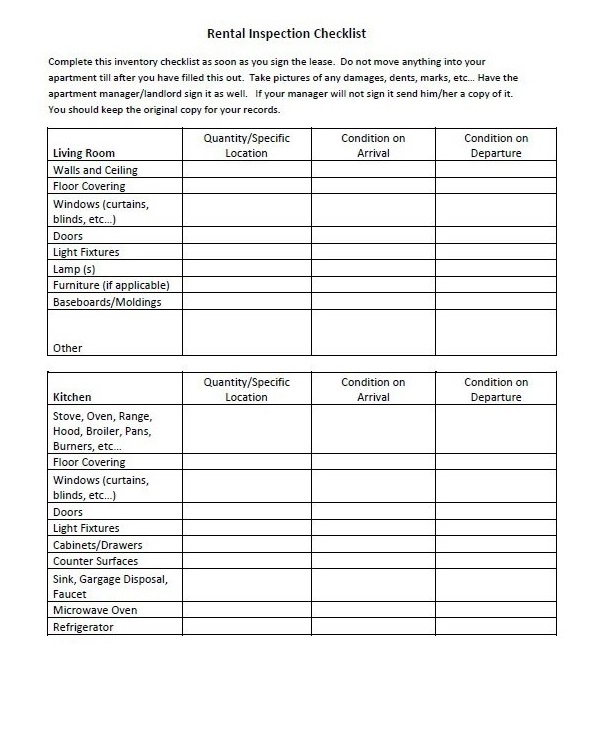
VA Home Inspection Checklist
This checklist is designed for homes purchased with a VA loan. It contains inspecting the home’s structural integrity, confirming the heating and electrical are secure and functional, and verifying that the home is free of hazards and pests. The VA has specific minimum property requirements that a home must meet to qualify for a VA loan.
New Home Inspection Checklist
This checklist is utilized when inspecting a newly built home. It includes inspecting the construction’s quality, ensuring all systems and appliances function correctly, and verifying that the home meets all local building codes. Even new homes can have issues, so it’s important to thoroughly inspect before purchasing.
FHA Home Inspection Checklist
This checklist is utilized for houses bought with an FHA loan. The FHA has specific requirements for the need of the house. The checklist contains:
- Checking the functionality of all systems.
- Ensuring the home is free of health and safety hazards.
- Verifying that the home is structurally sound.
Home Inspection Checklist for Buyers
This checklist is used by prospective home buyers during the house check. It contains inspecting the roof’s condition, checking the foundation for cracks or injury, confirming all systems (heating, electrical, plumbing) are functional, and checking for indications of pain infestations.
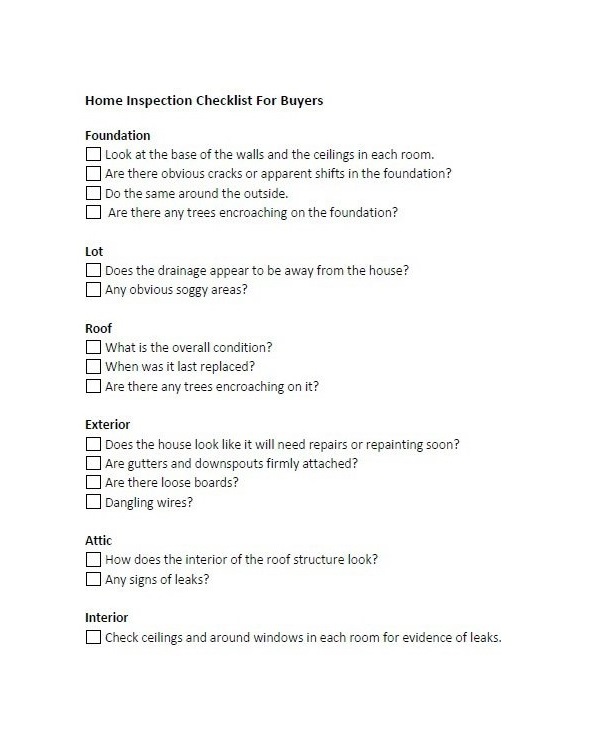
Home Inspection Checklist for Sellers
This checklist is used by home sellers to prepare for a buyer’s home inspection. It includes making necessary repairs, ensuring all systems are functional, and cleaning and decluttering the home. By addressing potential issues before the inspection, sellers can help the sale process go more smoothly.
Home Inspection Checklist Canada
This checklist is designed to meet the specific standards and regulations for home inspections in Canada. It includes checking the roof’s condition, inspecting the foundation for cracks or damage, ensuring all systems (heating, electrical, plumbing) are functional, and checking for signs of pest infestations or water damage.
Each of these checklists serves a specific purpose and can be invaluable in ensuring a home is safe, well-maintained, and a good investment.
Home Inspection Checklist Template
This general template can be a starting point for any home inspection. It typically includes exterior, interior, and all major home systems sections. This template can be customized to fit specific needs.
Home Inspection Checklist Word
This is a home inspection checklist that is formatted for Microsoft Word. It can be easily edited and customized to fit specific needs.
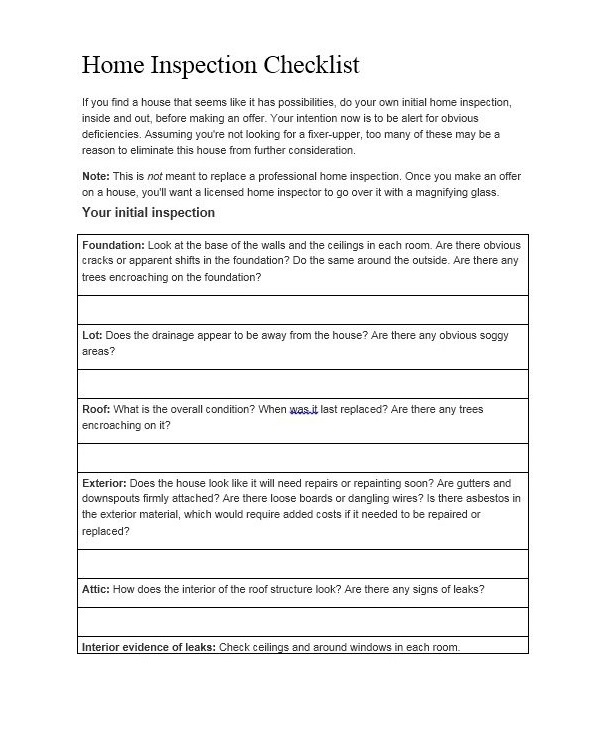
Home Inspection Checklist Ontario
This checklist is designed to meet the specific standards and regulations for home inspections in Ontario, Canada. It includes items similar to the general Canadian checklist but may have additional requirements based on local regulations.
Home Inspection Checklist Excel
This is a home inspection checklist that is formatted for Microsoft Excel. It can be easily edited and customized, allowing easy tracking and organization of inspection items.
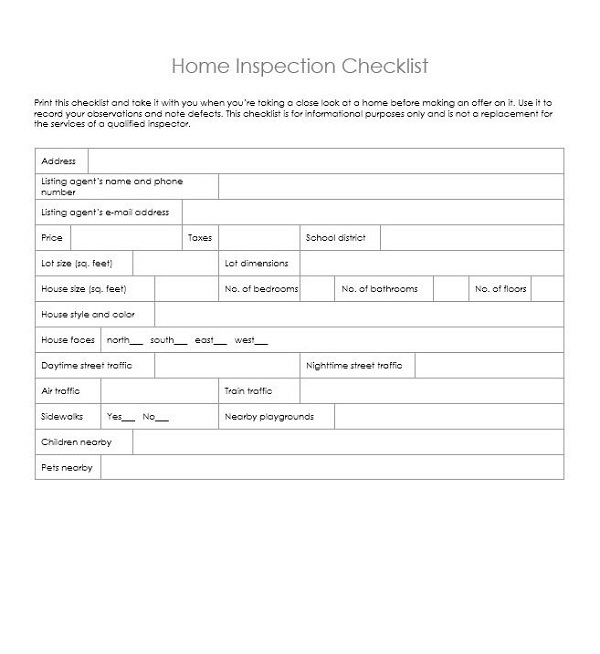
Home Inspection Checklist Printable
This is a printable version of a home inspection checklist. It can be printed and taken to a home inspection for easy reference and note-taking.
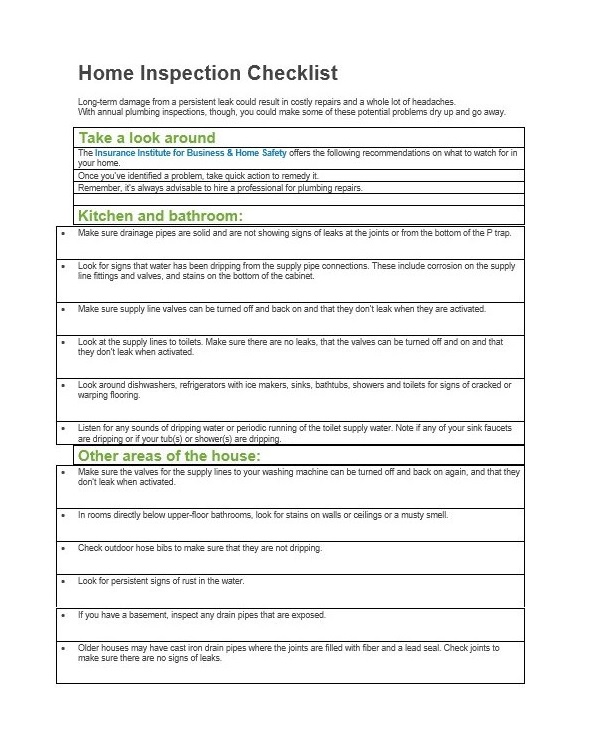
America’s Home Inspection Checklist Template
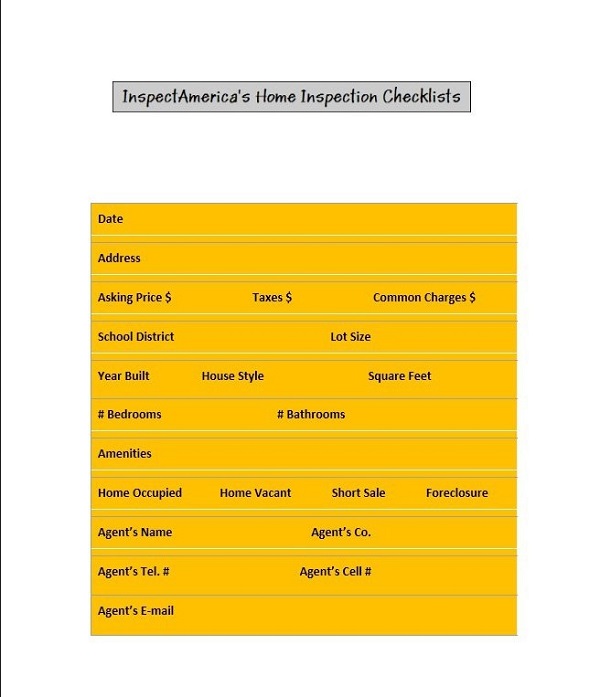
Do it Yourself Home Inspection
Walk-Through Home Inspection Checklist
DIY Home Inspection Checklist
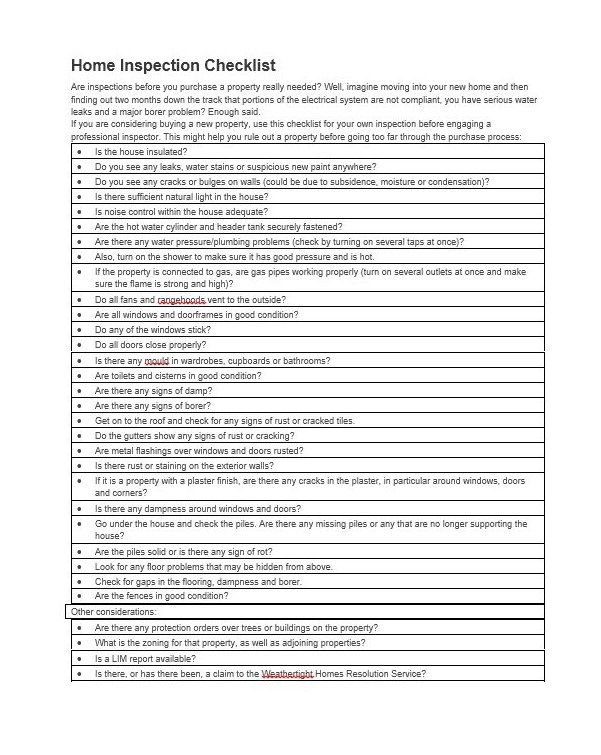
Professional Home Inspection Checklist
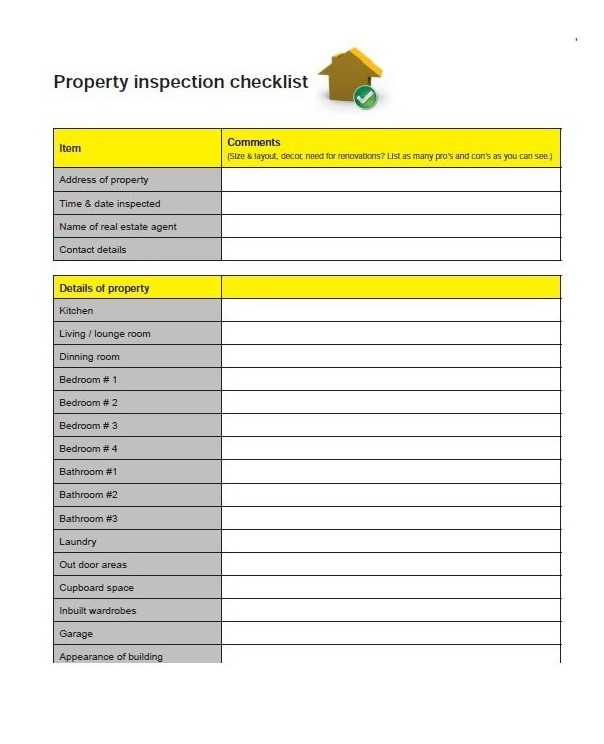
Detailed Home Inspection Checklist
Electrical System
Look for outdated wiring, non-functioning outlets, flickering lights, or circuit breakers that frequently trip. If any of these issues are found, consult with a licensed electrician. Electrical repairs can vary greatly, from a few hundred dollars for minor issues to several thousand for a complete rewiring.
Roof Examination
Check for missing or damaged shingles, leaks, or a sagging roofline. If these problems are identified, a professional roofer should be consulted. Roof repairs can range from a few hundred dollars for minor fixes to over $10,000 for a full replacement.
Air Conditioning and Heating System
Check for inconsistent temperatures, strange noises, or a constantly running system. If these issues are found, an HVAC professional should be contacted. Repairs can range from a few hundred dollars for minor issues to several thousand for a system replacement.
Wood and Pest Inspection
Look for signs of wood damage, such as holes, sawdust piles, or weakened wood. If these signs are present, a pest control professional should be consulted. The cost of pest control can vary but expect to pay a few hundred dollars for treatment.
Chimneys
Check for loose or missing bricks, a damaged flue liner, or signs of smoke damage. If these issues are found, a chimney professional should be contacted. Chimney repairs can range from a few hundred dollars for minor issues to several thousand for major repairs.
Septic and Sewer Structure
Look for signs of sewer backup, such as slow drains or sewage smells. A plumber or septic professional should be consulted if these signs are present. Sewer repairs can be costly, ranging from $1,000 to $4,000 or more.
Plumbing
Check for leaks, slow drains, or low water pressure. If these issues are found, a plumber should be contacted. Plumbing repairs can range from less than $100 for minor issues to several thousand for major repairs.
Using Home Inspection Checklist Templates
Home inspection checklist templates can be a valuable tool in guiding your inspection. They help ensure you pay attention to all important areas and provide a record of your findings.
To use a template effectively, start by reviewing the entire checklist to familiarize yourself with all the areas you’ll inspect. Then, as you go through each area, carefully check each item on the list. If you find any issues, note them on the checklist, along with any necessary follow-up actions.
Conclusion
A home inspection is a vital stage in the home-buying procedure. It fully assesses a property’s situation, helping possible customers understand what they’re getting into before buying. It is a valuable tool that examines all necessary home components, from the construction and systems to safety components.
Throughout this article, we’ve discussed the significance of a home inspection checklist, how to use it, and delivered tips for conducting a house inspection. We’ve also explored mistakes to avoid during house reviews and responded to often-asked queries about house inspections.
While performing a basic home inspection yourself is possible, hiring a professional is the best course of action. Experts have the training and knowledge to spot problems that might run overlooked.
FAQs
What is a home inspection?
It is a complete assessment of a property’s situation. It typically includes examining the home’s construction, systems (like HVAC and plumbing), and safety features.
Why is a home inspection important?
It is required because it assists possible customers in comprehending the house’s condition before buying. It can uncover secret problems that might be costly to fix.
Who conducts a home inspection? A professional house inspector usually performs a house inspection. These individuals are qualified to determine possible problems and evaluate the house’s situation.
What does a home inspection cover?
It typically covers the house’s construction, ceiling, floor, electrical system, plumbing, HVAC system, and more. It can also contain checks for safety problems like radon, asbestos, or mold.
What is a home inspection checklist?
It is an instrument used during a house review to examine all critical parts of the home. It can contain checking the roof for damage, testing the HVAC system, and checking the foundation.
Can I perform a home inspection myself? While performing a basic home inspection yourself is possible, hiring a professional is usually recommended. Professionals have the training and experience to spot issues that you might miss.
What happens if a home fails an inspection? If a home inspection reveals significant issues, it doesn’t necessarily mean the home “fails” the inspection. Instead, the findings can be used to negotiate repairs or a lower price with the seller.

The content creator team at calipsotree.com is dedicated to making topics accessible to everyone, with over 9 years of experience in writing and breaking down complex concepts into easy-to-understand articles that answer readers’ financial questions.






